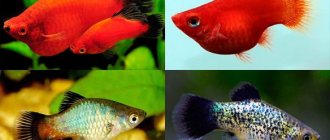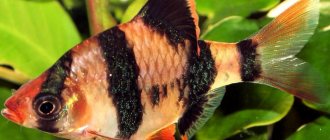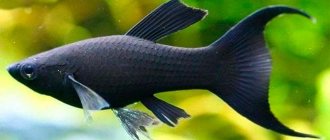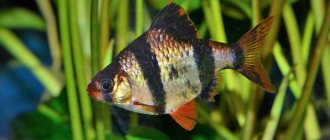- Wild animals
- >>
- Fish
The Sumatran barb is a freshwater fish that occupies the middle part of the aquarium. It has a beautiful appearance that attracts many aquarists and is really popular. However, it is not suitable for all aquariums. These fish have strong personalities, so it is advisable to be careful when storing them in a community aquarium.
Origin of the species and description
Photo: Sumatran barb
The Sumatran barb comes from the carp family and its scientific name is Puntius tetrazona. This fish is native to Indonesia in Southeast Asia. There is an albino variety of fish and a green variety, all of which are fast swimmers and love to tease other fish. They are very active, excellent swimmers, always on the move in open water, and love to chase and nibble on the fins of other calmer species. The Sumatran barb is quite sensitive to a large number of diseases.
Video: Sumatran Barb
The Sumatran barb is a fish that can increasingly be found in the aquarium. It is a big pollutant and a big oxygen consumer that requires excellent filtration and regular water changes. He is a very good swimmer, the length of the aquarium for him alone should be at least 1m 20 cm. To avoid attacks with other fish in the aquarium, it is necessary to keep them at least 10. Its beauty and behavior will be better displayed in a spacious aquarium with good company than alone in an aquarium, although its dynamism and aggressiveness make it difficult for many species to thrive.
Fun Fact: Healthier fish will have bright, rich colors and hints of red at the tip of the tail, fins and nose.
The Sumatran barb is relatively easy to care for and will reach a maximum size of 7-20cm once it reaches adulthood, making it an ideal size for keeping in an aquarium.
Compatibility
Sumatrans can be housed together with calm fish. But it is worth considering that if only a few individuals of this species live in a home aquarium, they become bored and begin to play with their neighbors, often biting off their tails and fins. Therefore, you should not keep Sumatran Barbs together with fish with veil fins (guppies), goldfish and gouramis.
Butterflyfish and Apistogramma Ramirezi are similar in appearance to Sumatrans, but have large beautiful fins and have a very calm and trusting nature. Therefore, they should not be housed together, even though the “butterflies” prefer the bottom layer.
They get along well with fairly fast representatives of aquarium fish. For example, thorns, catfish, diamond tetras, neons, etc.
Appearance and features
Photo: What does a Sumatran barb look like?
The body shape of the Sumatran barb is convex, the mouth is rounded, without serrations. The lateral line is incomplete. The general color is silvery-white, the backs are olive-brown, the sides have a red-brown glow.
The body has four dark transverse stripes with green metallic reflections:
- the first crosses the eye and almost crosses the lower edge of the gill bone;
- the second, located slightly in front of the back, in principle extends to the ventral line, but it is very variable and sometimes completely absent;
- the third is adjacent to a large black spot, which occupies the entire base of the back and is extended at the base of the anus;
- the fourth stripe ends the caudal peduncle.
The pelvic fins and dorsal coloration are bright red, the anal and caudal fins are more or less red, with variations depending on the age of the fish. The snout is more or less red. In addition, there are more or less random variations: black abdomen and pigmented eyes or albino, or green-black abdomen.
The Sumatran barb is a beautiful fish with black stripes. With a life expectancy of 5 years, the Sumatran barb can grow up to 7 cm as an adult.
Reviews
My husband became interested in aquarium fish. At first, I liked the water tank simply as a good air humidifier, but when my husband put a flock of colorful striped barbs in it, my attitude changed. Our whole family enjoys watching the behavior of these aquarium fish. This is just some kind of relaxation after a hard day. In addition, they turned out to be absolutely not difficult to care for. Irina, 42
At the bird market, I was attracted by the bright red color of a genetically modified Sumatran barb, so I immediately bought it and added it to the female guppies in the aquarium. At first everything was fine, but then a colleague at work shared two beautiful male guppies for my females. On the very first evening, the handsome men lost their tails, and by the morning, their lives. Since then, female guppies and one fighting barb have lived with me. So be careful!Nik86
Where does the Sumatran barb live?
Photo: Red Sumatran barb
Originating from the islands of Sumatra and Borneo, this species has been widely introduced and farmed in many countries as an ornamental fish, but some specimens have escaped into local streams. The Sumatran barb belongs to the group of striped tiger barbs from the Indo-Malayan region. The animal is quite difficult to systematize. Very close to it is the four-banded barb of the Malay Peninsula, which is distinguished by a pair of short maxillary antennae and some other differences.
Both forms were imported around the same time (1933 - 1935 in Germany); however, while the Sumatran barb has become one of the most popular species among hobbyists, the four-banded barb is losing ground, becoming less common on the market. The large genus Barbus from the subfamily Barbinae lives in the fresh waters of Europe, Asia and Africa. Among many divisions, which, depending on the circumstances, were considered as genera or subgenera.
It is worth noting the following:
- Barbus;
- Puntius;
- Systomus;
- Capoeta;
- Barbodes.
Some authors have placed all small exotic species in the Genus Puntius, and the Genus Barbus is used for large European species. Other authors divide them between Puntius, Capoeta and Barbodes. Finally, Genus Systomus wins in 2013, but Swiss ichthyologist Maurice Cottelat placed the species in the new Genus Puntigrus in November 2013 during the publication of the nomenclature.
In its natural environment, the Sumatran barb lives in acidic water. Acidification of water occurs from the decomposition of plants. This phenomenon changes the color of the water, which turns brown. In certain areas that are particularly rich in organic matter, the water becomes so altered that it is characterized as black. The species develops at shallow depths in areas with a high content of plants (aquatic and marsh plants, decaying organic matter, branches, etc.). The soil is usually sandy and humus. The Sumatran barb is a fish that lives naturally to temperatures between 26°C and 29°C. The pH of the water ranges from 5.0 to 6.5.
Raising fry
The process of development of a barb fry into an adult takes about 4 months. Young fish are capable of reproduction at the age of 5–6 months .
The fry must live in a separate aquarium until they reach maturity. During this period, the juveniles receive increased nutrition with live, plant food.
“Newborn” fry have a nondescript silver color. The characteristic olive color and stripes appear in fish closer to 2 months of life.
What does the Sumatran barb eat?
Photo: Sumatran barb in an aquarium
The Sumatran barb is an omnivore and will accept all foods offered to aquarium fish, but it has a preference for preying on live ones. In the wild, the barb feeds on worms, small crustaceans and plant matter. You should not overfeed them in excess, because they do not know how to limit themselves in their needs.
They will eat almost anything you offer them, including tropical fish flakes. All food should be consumed in less than 3 minutes. When feeding Sumatran barbs, you can alternate between live and dry food, but do not forget about vegetables.
Fun fact: Male Sumatran barbs have brighter colors, while females have duller colored bodies.
Dry food is fine for feeding them, but these fish prefer live prey or, if that is not available, they can eat frozen: brine shrimp, tubefex, grindaloo, mosquito larvae, daphnia, etc. Part of their diet should be vegetable in the form of algae (e.g. spirulina). Vegetarian fish is also recommended for daily food choices.
Sumatran barbs are colorful fish, so it is important to offer them food that will support their color and overall vitality. To increase protein intake, these fish will be happy to accept an occasional diet of freeze-dried and live foods, including brine, daphnia and others.
Now you know everything about the content of the Sumatran barb. Let's see how the fish survives in the wild.
Adviсe
- Do not overfeed barbs.
- Plant a sufficient number of plants.
- Choose a shallow aquarium rather than a long one.
- Do not share with slow and stately fish.
- Do not share with small fish or fry.
The Sumatran barb will enliven any aquarium with its cheerful temperament and will be an excellent decoration. If it seems to you that the aquarium has become slow and lifeless, then buy a barb. These fish will quickly create vigorous activity in the water; all you have to do is watch them.
(Visited 682 times, 1 visits today)
Features of character and lifestyle
Photo: Female Sumatran barb
The Sumatran barb has a multifaceted character. It can be very aggressive, especially if kept in a small aquarium. Like most barbs, he is very active and dynamic, has a sociable instinct and should live with someone nearby (it is worth making a group of 1 male for 2 females). The larger the aquarium, the more this fish will become wiser with other species.
Indeed, males will instead tend to quarrel and continue to fight among themselves for the attention of females. As a result, aggression will remain intraspecific. You will also see more beautiful colors by keeping Sumatran barbs in large numbers: these are competitive males that display themselves to the females.
This species likes to live in densely planted aquariums with plenty of rocks, logs and decorations in which to swim and hide. High-set aquariums are not necessary, but they will help keep the fish happy and provide them with enough space to breed successfully.
Interesting fact: Sumatran barbs love to create laws in the aquarium and spend most of their time chasing other aquarium inhabitants. They also have an unfortunate tendency to bite anything other than food: a hand, fish fangs, or even fins. If kept in too small a group or alone, this fish can become aggressive with other tank inhabitants.
Habitat
The second name is Sumatran puntius. In nature, the fish lives in Indonesia and southeast Asia (native of the islands of Sumatra and Kalimantan). Now it can be found in Singapore, Colombia and the USA. In the wild, the Sumatran barb lives in clean rivers with many plants, various stones and recessed tree branches. It feeds on algae, insects and detritus.
Social structure and reproduction
Photo: Sumatran barb fish
Reproduction of the Sumatran barb in an aquarium remains quite possible. To do this, you need to allocate a special aquarium to provide space for the fish in adulthood. Place a protective grid on the bottom of this aquarium (15 L) and decorate it with fine-leaved plants such as moss. Fill it with water and aim for a temperature of 26°C and a pH of 6.5/7. Add peat extract if possible. Prepare the parents by offering them an abundance of live prey.
When the females seem weightless, select a pair and place them in the breeding tank. Males are very aggressive and can even kill non-pregnant females. Therefore, if spawning does not occur within 24 hours, it is better to separate the pair and try again later. All barbs are oviparous. Eggs are laid in groups of 8-12 during sessions, which are often started by the females.
The fish crowd against each other in bunches of plants and, with strong tremors, release hammerheads and eggs (up to 500 - 600). The egg tray is at least 60 cm long. It is filled with fresh water, preferably pH 6.5-7 and fresh (well oxygenated), and supplied with several bunches of plants or artificial spawning support (nylon mop-type fibers). The water temperature is slightly higher (2° C) than that of the breeders.
They lay eggs in the evening and, as a rule, the last ones lie until the next morning. The rays of the rising sun contribute to this process. Parents are excommunicated at the end of bedtime. Hatching occurs within 24 to 48 hours. Newborn fish should be fed ciliate infusion for the first 4 or 5 days. Their growth occurs quickly and, if the aquarium is of sufficient size, young individuals lay eggs at the age of 10-12 months.
Feeding
The activity of the fish and its mobility formed a fairly accelerated digestion, the full cycle of which is 3-4 hours. In other words, these “bandits” are in constant motion and require regular feeding. 3-4 times during daylight hours, and without excess, it is better to slightly underfeed - the fish is gluttonous and prone to obesity. And leftover food in your aquarium will only lead to problems - an increase in nitrate levels, and the “can” becoming overgrown with unwanted algae. Therefore, it is more correct to feed as follows: the entire portion of food should be eaten “on the fly”, along the way from the surface to your soil.
You need to feed them simply but variedly:
- 10-15% of dry food is special flakes of plant or combined origin.
- The same amount of dry daphnia, bloodworms, cyclops.
- About 30% of “salads” are spinach, dandelion, riccia, wolffia, and oatmeal.
- Live food - bloodworms, carefully washed for several days, tubifex, daphnia, cyclops. Or frozen from the same bloodworms, daphnia, coretra, shrimp.
Barbus is omnivorous and voracious, but the main thing in its diet is variety. It requires carbohydrates that provide energy, proteins for growth, and a lot of vitamins for normal development. It is advisable for producers to even add a drop or two of fat-soluble vitamins A, D and E to dry food. And fasting days are useful, or rather, necessary. Complete fasting 3-4 times a month.
Natural enemies of Sumatran barbs
Photo: What does a Sumatran barb look like?
Sumatran barbs have few natural enemies. Sumatra has plenty of sunshine and the clear water makes it easy to spot these fish. But their yellow coloring with black stripes helps them hide from enemies. They go down to the sand to the bottom and take up space there among the stems of weeds, and you won’t be able to see it there at all. The dark stems on the yellow sand are similar to the stripes on the body of Sumatran barbs.
This species is threatened by disease. All fish diseases are divided into infectious (caused by viruses, bacteria, fungi and various parasites) and non-infectious (for example, congenital pathologies or poisoning due to poor ecology). In general, Sumatran barbs are characterized by excellent health and rarely get sick. Their most common illnesses are related to their “character”: they often simply infringe on themselves. The treatment for such cases is simple: hunger and only hunger. However, they, like any aquarium inhabitants, sometimes suffer from infectious diseases, but it is very difficult for a simple amateur without a specialist to make a correct diagnosis.
Any white spots on the body of the fish mean that the simplest parasites have settled in it. The common name for this disease is ichthyophthyriosis. The circulation of protozoa in an aquarium occurs easily, and getting rid of parasites is not an easy task. If white spots form on the head, closer to the nose, and turn into ulcers, then most likely the fish is suffering from hexamitosis, another parasitic disease. Sometimes simply changing the temperature of the water can help treat both, but special treatments such as miconazole or trypaflavin must be used.
Diseases
One of the most dangerous ailments of barbs, which is easily avoided, is obesity. It is also considered the most common cause of death.
Another disease is aeromonosis, popularly called rubella. Barbus can become infected through contact with sick fish or poorly treated soil and equipment. When sick, the body is covered with ulcers, the scales are raised, the eyes are excessively bulging, and the abdomen is swollen. The individual becomes lethargic and does not eat. In the early stages, they are treated with chloramphenicol or methylene blue, making baths out of them and putting sick fish in there. In the later stages, it will not be possible to save the fish.
Whiteskin also sometimes affects barbs. Damage occurs to the skin and nervous system. When infected, the skin around the dorsal and caudal fins turns white. Treat with chloramphenicol baths.
Differences between a female and a male
Sexual dimorphism is weakly expressed. It is impossible to determine the sex of a barb before puberty. The female can be distinguished by its larger size (5–7 mm in length) and enlarged abdomen. The coloring of the male is contrasting, the jaws are intensely orange.
The posterior edge of the anal fin of the female is inclined relative to the base of the tail by 60–90°. Males - at 30–45°.
Diseases
The Sumatran barb is so unpretentious that its owners often have the false idea that the striped fish living in the aquarium never get sick. This is wrong.
How long do barbs live? With good care and caring attitude, their life expectancy can be 5 – 7 years. But improper maintenance can lead to metabolic disorders or decreased immunity for brightly colored minke whales. In such cases, diseases such as the already mentioned obesity, gill and fin rot, white skin, rubella, and dropsy may occur.
Keeping barbs is an easy and very exciting activity. Some fish lovers prefer to set aside separate aquariums for them, the so-called barbecues. They can combine subspecies of different colors, creating a colorful and interesting picture of underwater life.
Preparing the fish
It is required in advance to seat different-sex individuals in separate tanks. Isolate fish no later than 10–14 days before spawning. But we must not delay. If the males are left too long, they begin to fight. Females that do not have the opportunity to mark for a long time begin to get sick.
Feed barbs ready for reproduction with frozen, but preferably live, food. About a third of the diet should consist of oatmeal. It is useful to give tablets with spirulina. About a day before spawning, a fasting day is done.
If males are ready to spawn, they begin to show aggression. You can determine if a female is pregnant not only by an enlarged belly, but also by a swollen anus.
Individuals of normal size, without defects in color and structure, are suitable for breeding.
Caviar yield
After spawning is completed and the breeders return to the general aquarium, you need to reduce the amount of water in the tank to 10 cm. The mesh is removed after 12 hours and carefully removed from the eggs.
Next you need to add methylene blue to the water. This prevents contamination of the eggs and helps to find unfertilized specimens.
After about a day, the larvae begin to appear. At first, they feed on the reserves of the gall sac. After 12 hours, change half of the water to boiled or distilled. Three days later the fry appear.
To prevent mutation of eggs and to avoid colors unusual for barbs, you need to shade the aquarium.
Difficulty in content
Well suited for a large number of aquariums and can be kept even by beginners. They tolerate a change of place of residence well, without losing their appetite and activity.
However, the aquarium must have clean and well-aerated water. And you can’t keep it with all fish; for example, goldfish will be subject to permanent stress.
The same goes for fish with long, veiled fins or slow-moving fish. The peculiarity of his character is that he can pinch his neighbors' fins.
This behavior is typical for fish that do not live in a school, since keeping them in a school forces them to maintain a hierarchy and deal with their relatives.
Avoid two things: keeping one or two barbs and combining them with fish that have long fins.
Mating games
It is required to select two manufacturers. If the queen begins to attack too much and attack the male, it is better to replace him, otherwise you may be left without offspring at all.
There must be algae in the tank, as it provides protection to the parents. When the fish calm down, they are quickly transplanted into a common aquarium. The completion of spawning is also indicated by the behavior of the female, as she begins to avoid contact with the male.
Approximately 12 hours after the completion of spawning, eggs without an embryo can be identified - they become white and cloudy. It can be easily removed using a pipette.











